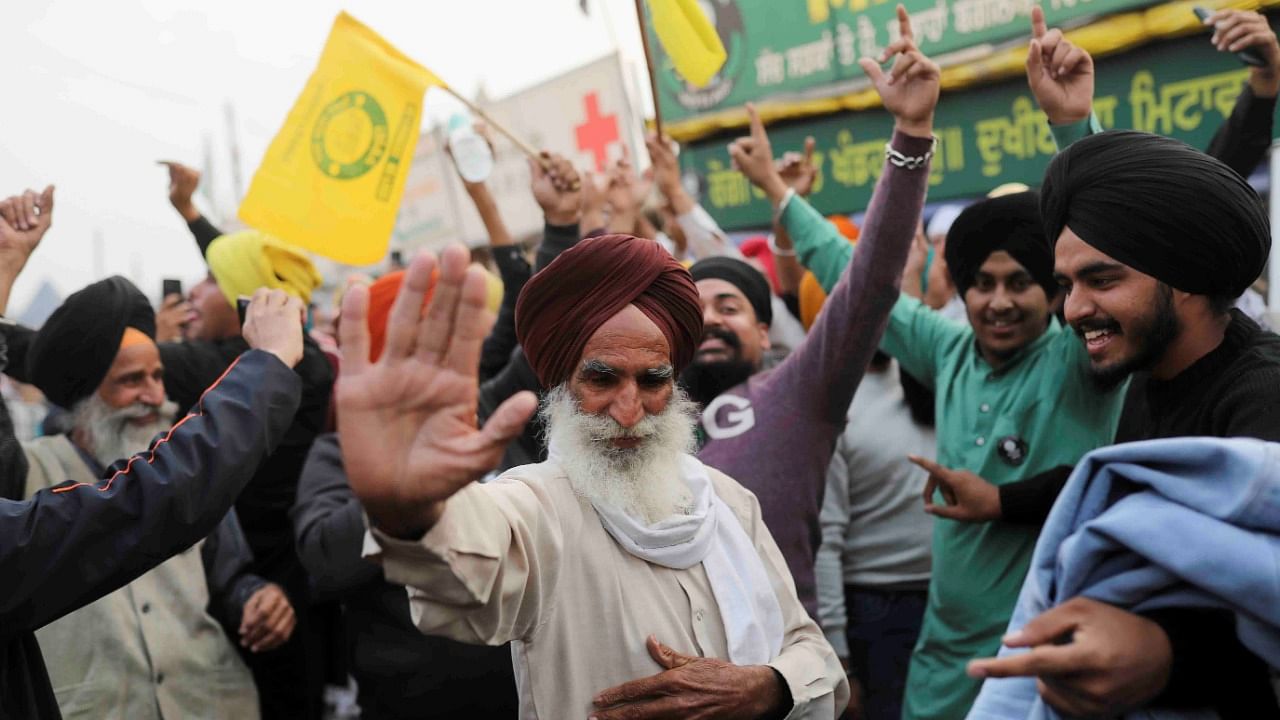
Prime Minister Narendra Modi's announcement of the repeal of farm laws came in nearly the same manner as the declaration of demonetisation five years ago. That was also the month of November. Although, the element of surprise was more significant and impact more widespread as it affected each of the 100-crore plus Indians.
Sure enough, scrapping of the controversial farm laws, against which farmers have been on the warpath for a year, is bound to affect only the agriculturist community across the length and breadth of the country – even in those areas where farmers had not taken to street demonstrations.
Undaunted by the odds, including vagaries of nature and intense opposition by the government, the agitating farmers remained unrelenting and maintained their spirits at the sit-ins they staged on the borders of Delhi uninterrupted for 12 long months. No wonder several analysts sought to describe it as the most extensive farmers movement on the planet.
Apart from physical obstructions, those at the helm of affairs made all kinds of verbal onslaughts. The agitators were called "Khalistanis", "separatists", and even "terrorists", pointedly accused of receiving funding from foreign nations, including Pakistan and China.
While the ruling dispensation insisted the three new farm laws were in the larger interest of farmers, the farmers stuck to their guns, terming the new laws a conduit to benefit select crony capitalists. The agitating farmers believed that the laws would end up making them bonded slaves.
There is no doubt that the government made repeated efforts to convince the farmers. However, their effort largely reiterated the same claims and contentions that the protesters had rejected on Day One.
It reached a stage that in their bid to run down the protests, the Union government and even the BJP-ruled states spread a canard that very few farmers were among the protesters. The idea was to defame the movement as "opposition sponsored".
However, when all vilification failed, the man at the helm decided to show magnanimity and bow to the wishes of the farmers, whose one-point demand was scrapping of the laws unilaterally unleashed upon them. And the day – Guru Nanak Jayanti – was also chosen with another political purpose. After all, the entire movement was spearheaded by Sikh farmers, and state assembly elections in Punjab are to follow Uttar Pradesh.
The larger chunk of the mainstream media was out to term the prime minister's announcement reflecting his "large-heartedness". However, political analysts were dismissive of such proclamations and felt the political compulsion of the forthcoming Uttar Pradesh polls led the prime minister to backtrack.
Apart from internal intelligence reports, which pointed towards the adverse political impact of the government's stiff stand against the farmers' demand, the ruling dispensation had begun to see the hurdles posed before them on this account. Reports from several parts of western UP said top BJP leaders, including a Union minister, were physically prevented from entering their villages to campaign for the BJP. That followed an open declaration by Kisan Morcha leader Rakesh Tikait that farmers would not allow any ruling party leader to step into their respective villages.
In western UP, the BJP had won as many as 112 of the 136 seats in the last Assembly election of 2017, primarily because of the communal divide that followed the infamous 2013 Muzaffarnagar riots that left 67 dead and tens of thousands displaced. The polarization of Hindus in favour of the BJP gave it a massive boost. Interestingly, the farmers' protest once again reunited the two divided communities. The dominant Jat population in the region was in close collaboration with Muslims during the entire movement, giving sleepless nights to the BJP.
At the highest levels, it had become evident the feared loss of seats in western UP was unlikely to get compensated in other parts of UP because of what people had gone through during the second phase of Covid-19. There were unaccounted deaths in the vast rural expanse due to a shortage of oxygen and want of treatment in hospitals. The plight of people who had to either immerse the bodies of their kin in Ganga and other rivers or bury them on the river banks is still fresh in the minds of people.
With elections around the corner, the prime minister did not want any confrontation. Hence, even the otherwise aggressive UP Chief Minister Yogi Adityanath was told not to use any force against the farmers. On his recent visit to Lucknow, Union Home Minister Amit Shah said 2022 was crucial for the BJP in Uttar Pradesh because Modi has to be re-elected as PM for a third term in 2024. "If you want Modi to become PM in 2024, you must make Yogi the CM once again in 2022", Shah declared.
Indeed, this was the rarest of the rare occasion when an all-powerful prime minister decided to give in to the demands of undaunted and unrelenting farmers. It was not just a victory of farmers but also a victory of democracy over autocracy.
(Sharat Pradhan is a journalist based in Lucknow)
Disclaimer: The views expressed above are the author's own. They do not necessarily reflect the views of DH.
Watch the latest DH Videos here: